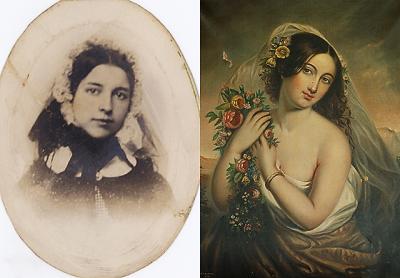A Fordham Painting, Long Lost, Is Found Again in Sag Harbor

A comedian popular in the 1970s — maybe George Carlin or David Brenner — once asked why people say that they found something in “the last place I’d look for it.” The punch line was, “Well, of course it was the last place. Once you find it, why would you keep looking for it?”
The discovery in Sag Harbor of “Crowning of Mercy,” an 1869 Hubbard Latham Fordham allegorical painting, has the kind of back story that prompts one to think of such punch lines.
Active at times in New York City, New Haven, Conn., and Springfield, Mass., the self-taught artist is best known on the South Fork for the time he spent here as a portraitist and keeper of the Cedar Island Lighthouse from 1849 to 1853 and from 1862 to 1869. He was born in Sag Harbor in 1794 and died there in 1872.
Jean Held, a Sag Harbor Historical Society trustee, recently explained that in the mid-2000s, Pamela Lawson, who was a trustee at that time, was researching Fordham paintings and their current locations for the society. “I used to be in the library researching nature studies,” Ms. Held recalled. “She was in the library looking at art.”
In 2005, Ms. Held found an article in The Sag Harbor Express from July 1869 that described a Fordham painting that had not been accounted for since then. According to the article, “Mr. Hubbard L. Fordham has just finished another picture representing the ‘Crowning of Mercy,’ which is a handsomely executed piece, and shows a fine specimen of workmanship.” She gave the article to Ms. Lawson, who added the painting to her list with a note that its location was unknown.
By this point, the Sag Harbor Historical Society had moved into the Annie Cooper Boyd house on Main Street, a house left to the society by Nancy Boyd Willey, Boyd’s daughter, who died in 1998. Although the society was using the house as its headquarters, efforts to restore the attic did not take place until 2010, some five years after Ms. Held first saw the article describing the painting.
“I was in the attic cleaning out a filthy closet,” she said. Next to an old air conditioner, she noticed a canvas. Not only was it dirty, she said it looked like “something you would find in a 10-cent store, which is a horrible thing to say about this painting.” She put it aside.
Some time later, she went upstairs and reconsidered. “I was trying to figure out if it was really a significant painting.” It was signed and it had a date, which corresponded with the date in the article. Yet, Fordham did not usually sign his paintings. “I thought someone else, maybe Annie Cooper Boyd, might have done it. . . . It was a sloppy signature, crude, it made me suspicious.”
By then, Ms. Lawson was in a nursing home and Geoffrey Fleming, another expert, had moved away from Bridgehampton. Ms. Held finally reached out to Richard Barons, the recently retired director of the East Hampton Historical Society, and he helped confirm the painting’s authenticity in February. According to Ms. Held, he called it a “splendid example of high Victorian idealization,” which, given modern taste, could be taken as similar to Ms. Held’s initial assessment.
She sent a photo of the painting with Mr. Barons’s notes to the Century Arts Foundation, and by April she had a grant for its restoration, now being handled by Larry Castagna, an East Hampton conservator.
In the interim, Ms. Held also found a familiar-looking photograph in the house. It was a picture of Emily Fairchild Fordham Keese. On a hunch, she compared the image to the painting and concluded that she was likely the model for the painting. Keese was the mother of Boyd’s best friend, Virginia Keese, known as Pussy.
In a rather colorful history compiled by a volunteer researcher for the society, Keese and Boyd became rivals for the affection of their Presbyterian minister, a Reverend Kamp. Kamp chose Keese, but committed suicide before they were married. She never married and became the John Jermain librarian.
Keese and Boyd remained friends and Ms. Willey was good friends with Keese’s niece Emily. It is not a stretch to see how some of the Keese family’s possessions may have turned up in the Boyd household. “We have scrapbooks from the Keese family,” Ms. Held said. “It makes sense that we ended up with the painting and a photo of the model.” She added that Fordham painted Boyd’s father.
Although known mostly for his portraits here, there are 12 narrative paintings on the list compiled by Ms. Lawson. The subjects include “The Finding of Moses,” “The Triumph of Virtue,” “Descent From the Cross,” and “Two Escaping Slaves Pursued by Bloodhounds.” Except for the “Crowning of Mercy,” all of their locations are unknown.
“For all of the time Pam Lawson was doing research to find these paintings, this one was upstairs,” Ms. Held said. “We just needed to find it.”
